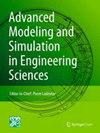Geometry aware physics informed neural network surrogate for solving Navier–Stokes equation (GAPINN)
IF 3.2
Q3 MECHANICS
Advanced Modeling and Simulation in Engineering Sciences
Pub Date : 2022-06-21
DOI:10.1186/s40323-022-00221-z
引用次数: 15
Abstract
Many real world problems involve fluid flow phenomena, typically be described by the Navier–Stokes equations. The Navier–Stokes equations are partial differential equations (PDEs) with highly nonlinear properties. Currently mostly used methods solve this differential equation by discretizing geometries. In the field of fluid mechanics the finite volume method (FVM) is widely used for numerical flow simulation, so-called computational fluid dynamics (CFD). Due to high computational costs and cumbersome generation of the discretization they are not widely used in real time applications. Our presented work focuses on advancing PDE-constrained deep learning frameworks for more real-world applications with irregular geometries without parameterization. We present a Deep Neural Network framework that generate surrogates for non-geometric boundaries by data free solely physics driven training, by minimizing the residuals of the governing PDEs (i.e., conservation laws) so that no computationally expensive CFD simulation data is needed. We named this method geometry aware physics informed neural network—GAPINN. The framework involves three network types. The first network reduces the dimensions of the irregular geometries to a latent representation. In this work we used a Variational-Auto-Encoder (VAE) for this task. We proposed the concept of using this latent representation in combination with spatial coordinates as input for PINNs. Using PINNs we showed that it is possible to train a surrogate model purely driven on the reduction of the residuals of the underlying PDE for irregular non-parametric geometries. Furthermore, we showed the way of designing a boundary constraining network (BCN) to hardly enforce boundary conditions during training of the PINN. We evaluated this concept on test cases in the fields of biofluidmechanics. The experiments comprise laminar flow (Re = 500) in irregular shaped vessels. The main highlight of the presented GAPINN is the use of PINNs on irregular non-parameterized geometries. Despite that we showed the usage of this framework for Navier Stokes equations, it should be feasible to adapt this framework for other problems described by PDEs.求解Navier-Stokes方程(GAPINN)的几何感知物理神经网络代理
许多现实世界的问题都涉及流体流动现象,通常用Navier-Stokes方程来描述。Navier-Stokes方程是一类具有高度非线性性质的偏微分方程。目前常用的求解该微分方程的方法主要是离散几何。在流体力学领域,有限体积法(FVM)被广泛用于数值流动模拟,即计算流体动力学(CFD)。由于计算成本高,离散化生成繁琐,在实时应用中没有得到广泛应用。我们提出的工作重点是推进pde约束的深度学习框架,用于更多具有不规则几何形状而没有参数化的实际应用。我们提出了一个深度神经网络框架,通过数据自由的物理驱动训练生成非几何边界的代理,通过最小化控制偏微分方程的残差(即守恒定律),因此不需要计算昂贵的CFD模拟数据。我们将这种方法命名为几何感知物理通知神经网络gapinn。该框架涉及三种网络类型。第一个网络将不规则几何图形的维度降低到一个潜在的表示。在这项工作中,我们使用了可变自动编码器(VAE)来完成这项任务。我们提出了将这种潜在表征与空间坐标相结合作为pin输入的概念。使用pinn,我们证明了可以训练一个代理模型,该模型纯粹是由不规则非参数几何的基础PDE的残差的减少驱动的。此外,我们还展示了设计边界约束网络(BCN)的方法,该网络在训练过程中几乎不强制执行边界条件。我们在生物流体力学领域的测试案例中评估了这一概念。实验包括不规则形状容器中的层流(Re = 500)。提出的GAPINN的主要亮点是在不规则的非参数化几何上使用pinn。尽管我们展示了该框架对Navier Stokes方程的使用,但将该框架用于偏微分方程描述的其他问题应该是可行的。
本文章由计算机程序翻译,如有差异,请以英文原文为准。
求助全文
约1分钟内获得全文
求助全文
来源期刊

Advanced Modeling and Simulation in Engineering Sciences
Engineering-Engineering (miscellaneous)
CiteScore
6.80
自引率
0.00%
发文量
22
审稿时长
30 weeks
期刊介绍:
The research topics addressed by Advanced Modeling and Simulation in Engineering Sciences (AMSES) cover the vast domain of the advanced modeling and simulation of materials, processes and structures governed by the laws of mechanics. The emphasis is on advanced and innovative modeling approaches and numerical strategies. The main objective is to describe the actual physics of large mechanical systems with complicated geometries as accurately as possible using complex, highly nonlinear and coupled multiphysics and multiscale models, and then to carry out simulations with these complex models as rapidly as possible. In other words, this research revolves around efficient numerical modeling along with model verification and validation. Therefore, the corresponding papers deal with advanced modeling and simulation, efficient optimization, inverse analysis, data-driven computation and simulation-based control. These challenging issues require multidisciplinary efforts – particularly in modeling, numerical analysis and computer science – which are treated in this journal.
 求助内容:
求助内容: 应助结果提醒方式:
应助结果提醒方式:


